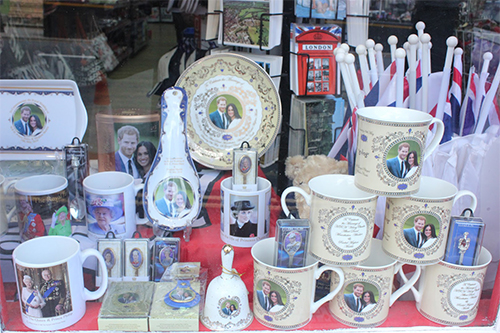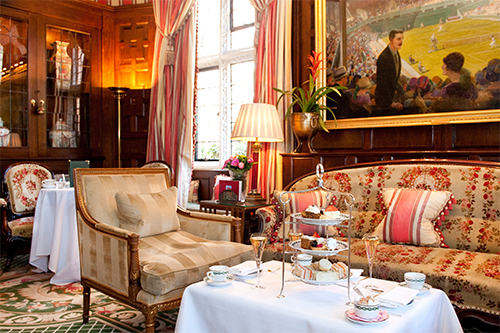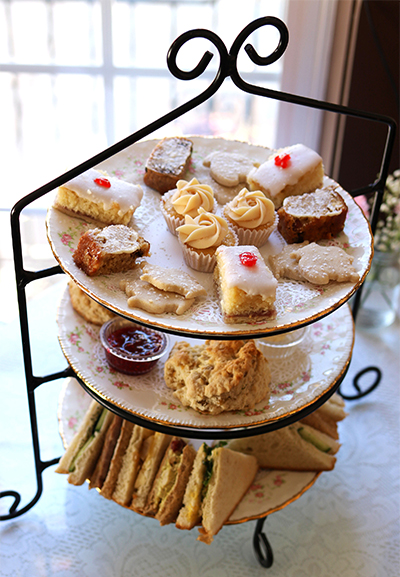On Kensington High Street in London, near Kensington Palace, where newlyweds Meghan Markle and Prince Harry will reside after their nuptials, I was awash in a tsunami of red, white, and blue kitsch at the Nonstop Party Shop. Union Jacks side-by-side with the Stars and Stripes, tea cups bearing the smiling faces of the couple, tacky costumes, bobble heads, and other knickknacks and curios were all displayed in a flamboyant hodge-podge.
“British people come in here,” says Lily Carr-Gomm, the clerk on duty, “and they go ‘Ugh, do people actually buy this stuff?’ And the answer is ‘Well, it’s mostly Americans. The wedding really means more to Americans than it does to the British.”

Just as Americans get more excited by Cinco de Mayo than do the people in Mexico, and more excited about St. Patrick’s Day than do the Irish, so are Americans at least as excited about the royal wedding as the English. And that’s why many of you Chicagoans will be up at 6 a.m. on May 19 to watch the marriage of Meghan Markle, a California girl who went to Northwestern University, and Harry, youngest son of Charles and Diana. (Here’s all you need to know about how and where to watch.)
So, what should you serve while watching the early Saturday morning telecast from Windsor Castle?
Tea. Obviously! And in England, “tea” frequently means more than simply the warm beverage: It means savory sandwiches, scones, and sweets.
You’ve probably heard tell of “high tea.” In England, traditionally, high tea was humbler, less formalized, and likely to include portions of food as big as an entrée sometimes served to people sitting at high-top tables. Low tea, or afternoon tea, was the more formal version, served on low tables and comfy sofas or stuffed chairs. Today, these distinctions have become blurred, and it’s been reported that the fancier low or afternoon tea “served in the UK today is often referred to as high tea in many other parts of the world. Because of this, some hotels, such as The Ritz in London, use the term ‘high tea’ to advertise their afternoon tea because a large proportion of their customers are from overseas.” The same is true in Chicago. Check out some of our favorite spots for afternoon tea.
While in London, we enjoyed what was called a “royal tea” at the Milestone Hotel and Residences, a posh place across the street from Kensington Palace. Andrew Pike, Milestone’s general manager, had a few tips for those intending to serve tea during the wedding festivities. A good rule of thumb is that you don’t have to be fancy, but it’s a good idea to include a few traditional sandwiches that usually accompany the classic English tea. They don’t require a great deal of time to prepare, but, Pike cautions, care must still be taken.

“Sandwiches are easy to make but the most likely to disappoint,” Pike says, a slight frown creeping across his otherwise jovial countenance. “People put in too little. The filling — meat, cheese, and so on — must be just about the thickness of one slice of the bread.”
“The classic tea accompaniments are cucumber sandwiches, with the cucumber sliced thin, on buttered bread,” says Pike, “as well as ham and mustard, egg salad with watercress, and salmon. It’s traditional to make the sandwiches with a few different breads (light, dark, wheat, etc.). Making sandwiches for tea is very like making sandwiches for a toddler — cut off the crusts and then cut each sandwich into three thin slices.”
At the Milestone, scones are served as a bridge between the savory and the sweet courses. They come right from the oven, “because we want our guests to enjoy the scones warm,” explains Pike, “and you should never serve the savory and sweet items together. That would be boorish.”
Pike suggests that “the host traditionally serves the guest, and everything is usually presented on a three-tiered plate rack, not a buffet.” Such formalities, however, are flexible, particularly in the former colonies.
Pike recommends breaking or cutting the scone in half and applying jam before you layer on the Devonshire cream. “That way,” he says, “the cream doesn’t melt on the hot scone and become little more than butter. The jam forms a barrier between the warm cake and the cream, and you can enjoy the texture and richness of the still cool cream.”
After the savory sandwiches and scones come the sweet items. Macarons are “a must,” says Pike, as are tarts and cupcakes.
A high-quality restaurant or tea room will give guests the option of several different teas. Darker teas, like Assam or Earl Grey, are served with the savory items, and fruit-forward teas are served with the sweeter ones. Just as you would serve different wines with different courses of a dinner, you can serve teas at different points in the tea service.
The British, unlike many in Asia and other tea-drinking nations, prefer milk in their tea, a carry-over from colonial days when much of the tea coming into the country was harsh and needed milk’s creaminess to take the edge off. All of which raises the big question: Does one add tea to milk or milk to tea? “In Georgian times,” says Pike,” the china cups were very thin, and it was thought that they might break when hot tea was poured into them. So, they poured in milk first, then hot tea.”
If you’re planning to have an English-style tea for a royal wedding viewing party, procuring the ingredients for the finger sandwiches will be easy; most delis can provide the sliced meat, cheese, or salmon, and if you care to make the effort, you can slice some cucumbers and prepare an egg salad. Many tea rooms, however, have their own unique signature sandwiches, so feel free to be creative. For instance, because the royal wedding will be broadcast so early in the morning (before dawn on the West Coast), consider a breakfast bacon and egg finger sandwich. (Why not? It’s the 21st century, and we’re in America, y’all.)
Sweet pastries are not hard to come by and will keep well overnight, but scones can be tricky. If you buy scones the night before, you can re-heat them in the oven, but Pike urges you to avoid resorting to the microwave. “If you zap the scones in a microwave, and you keep them in 2-3 seconds too long, the scones will get biscuit-y. I would really not recommend it.”
As I sip tea with Pike, I mention that I had heard some talk that Meghan and Harry had been by his hotel to enjoy a private dinner, which seemed possible as Kensington Palace is a three-minute limo ride from the Milestone. “Well,” Pike smiles, with impish reserve, “I really am not allowed to say.”
Where to Get the Fixings for a Proper Tea at Home
There are several reliable sources for tea in the area. We recommend loose leaf tea from high-quality tea merchants Todd & Holland in Forest Park or Tina’s Traditional Tea Room in Carmel, Indiana. Both Todd & Holland and Tina’s pay special attention to proper English tea service, and teas, scone mixes and other edibles, and china can all be ordered online.

Appropriate pastries are not challenging to come by — even Starbucks usually offers three varieties of scones — but we’re partial to the finely crafted baked goods at Floriole, in the Sheffield neighborhood, which also carries scones, croissants, and the sweet pastries of the type you’d see at tea service in England.
You may not find any local store offering the range of kitschy memorabilia that you’d pick up at places like Kensington’s Nonstop Party shop, though you might consider snagging a Union Jack at Quizhpe’s Flags & Sports (2242 N. Western, Chicago, no website — how old timey!).
And, as we’ve already told you, three-tiered sandwich trays are traditional for a proper English tea … so if you have them, you won’t find a better time to use them.
If You’d Rather Someone Else Do the Work…
Royal wedding viewing parties will be held at places like The Drake, III Forks in River North, and R Public House in Rogers Park. Cocktails may replace tea at some of these events — Yanks may be fascinated by the ritual of an English tea service, but many of us prefer a cocktail to a cuppa.
Cheers to Harry and Meghan!
 David Hammond is Dining and Drinking Editor at Newcity and contributes to the Chicago Tribune and other publications. In 2004, he co-founded LTHForum.com, the 15,000 member food chat site; for several years he wrote weekly “Food Detective” columns in the Chicago Sun-Times; he writes weekly food columns for Wednesday Journal. He has written extensively about the culinary traditions of Mexico and Southeast Asia and contributed several chapters to “Street Food Around the World.”
David Hammond is Dining and Drinking Editor at Newcity and contributes to the Chicago Tribune and other publications. In 2004, he co-founded LTHForum.com, the 15,000 member food chat site; for several years he wrote weekly “Food Detective” columns in the Chicago Sun-Times; he writes weekly food columns for Wednesday Journal. He has written extensively about the culinary traditions of Mexico and Southeast Asia and contributed several chapters to “Street Food Around the World.”
David is a supporter of S.A.C.R.E.D., Saving Agave for Culture, Recreation, Education and Development, an organization founded by Chicagoan Lou Bankand dedicated to increasing awareness of agave distillates and ensuring that the benefits of that awareness flow to the villages of Oaxaca, Mexico. Currently, S.A.C.R.E.D is funding the development of agave farms, a library and water preservation systems for the community of Santa Catarina Minas, Oaxaca.

